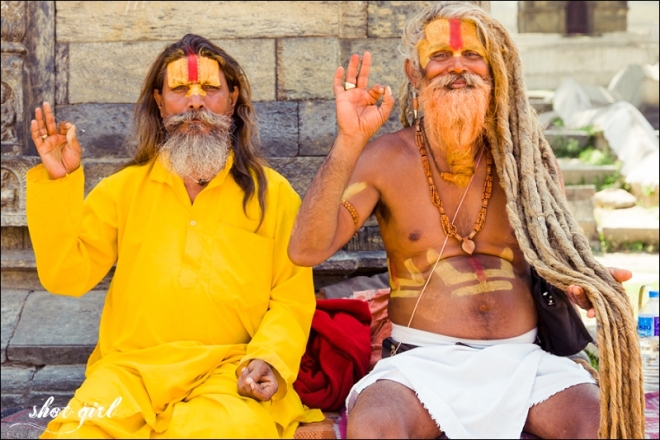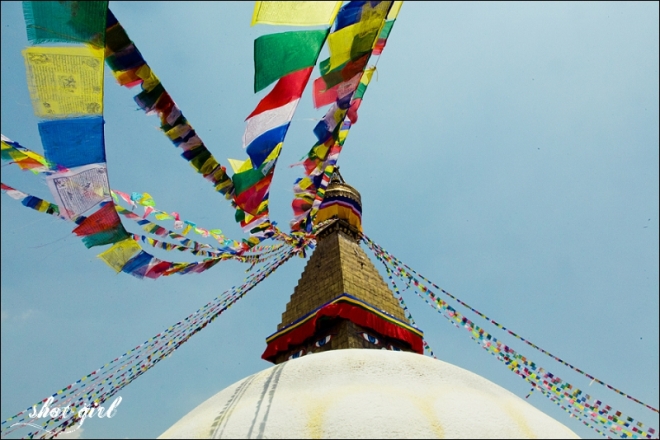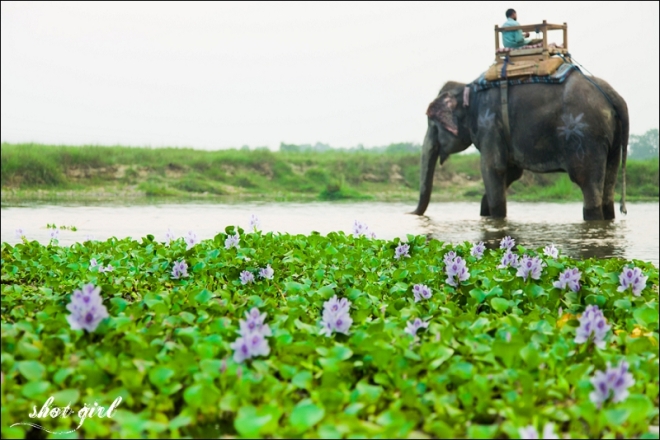And so my adventure begins. Namaste Nepal… Welcome to Nepal.
Kathmandu is an exhilarating shock; it can be an intoxicating, amazing and an exhausting place. Stepping off the plane, the sights and sounds lead to sensory overload. Even though I mentally prepared myself I was still taken aback by the hustle and bustle of the city. Was this what they meant by a cultural shock or was it just a case of having been a London city girl for far too long living in my safety cocoon with all its modern conveniences?
Exiting the airport, I negotiated a taxi to my accommodation only to find that the mode of transport was a beaten up Toyota Datsun, which looked barely functional let alone safe enough getting me from A to B. Driving through Nepal is an adventure on its own. In some countries they are known as stunt drivers but in Nepal they are known as Taxi or Bus Drivers and there are no rules when it comes to driving. It seems to be normal to overtake another car/bus/motorbike in oncoming traffic. My heart nearly stopped numerous times and I couldn’t help but close my eyes and peek out under my eyelashes as we played chicken with the oncoming traffic. My stunt driver, however, seemed to know what he was doing and he weaved his way through the narrow dusty streets of Kathmandu. Cows which are sacred, freely roam on the main roads and there is rubble lying on the streets from the many broken down buildings (which I later found out was due to land reclamation to widen the roads for transportation) and people are milling about everywhere. Many of the Nepalese wear masks in the old sections of the town as the air quality is poor.
Wondering what kind of adventure I have signed up for, I checked into my accommodation, not sure if I was quite ready to venture out of the safety of my oasis into the streets of Thamel. My stomach gave a rumble, and I decided I was certainly brave enough to find lunch. I watched life go by, slowing getting more confident of my surroundings as the minutes ticked by. After lunch, I ventured further and I discovered what was appropriately called the Dream Garden, an oasis amidst busy Kathmandu. Beautiful sculptured lawns and water features, and people lying on the grassy lawns, napping or reading their books. The streets of Kathmandu melted away. I eventually left my oasis of dreams, and walked back to my accommodation in the golden glow of the afternoon sun.
Somehow Kathmandu seemed less confronting at night as I wandered through the busy streets and had dinner at a Tandoori family run restaurant, tucked away in a little corner, where the curries are freshly prepared and Naan bread is baked in an oven kiln. I hardly sat down and ordered my meal and I experienced my first scheduled power cut in Nepal. This I was soon to learn was a daily occurrence, and varies from region to region but can last for hours. The lights dimmed, and the streets went dark and the power generator kicked in. Dinner was by a solitary light.
The next morning I woke up bright and early, determined to conquer the streets of Kathmandu, and set off for Durbar square. Durbar Square (Durbar means Palace) was where the city’s kings were once crowned and from where they ruled. The square is the traditional heart of the old town and Kathmandu’s most spectacular legacy of traditional architecture.
It is easy to spend hours wandering around the square, if you are happy to contend with those trying to sell you their wares. Milling around, I wandered up to one of the temples and came across a Kumari Ceremony. The Kumari is known in Nepal as the protector from evil and the bestower of good luck and prosperity. The Kumari, literally meaning ‘virgin’, is a young girl chosen from the Buddhist community to represent a Hindu goddess after she passes 32 tests of ‘perfection’. According to Kumari tradition, girls selected from Buddhist Newar families through a rigorous cultural process become the ‘living goddesses’.
Around another corner, I stumbled onto a square where the combination of pigeons and pagodas lent this square an out-of-the-world charm. Grand and royal.
Feeling a little more settled in Kathmandu, I met with my Gecko’s tour group for a tour briefing, I was going to be spending two weeks with the party of four and Krishh was going to help us navigate our way through Nepal.
Kicking off the tour the next morning, we swung past the famous Hindu temple in the country, Pashupatinath where we experienced the Hindu’s preparing their loved ones for cremation. Being allowed to see it is a huge privilege, Hindu temples are normally strict about not letting non-Hindus see their rites and we watched the rituals across the water, a few funeral piles already burning and the smoke wafting across. We watched the ceremony in various stages from start to finish as the dead were carried to the holy river, feet bathed, and the custom of preparing the body for cremation, right through to the laying of the body on the wooden platform, placing the fire in the mouth and then covering the body and allowing the cremation to take place. I won’t lie, it was pretty moving stuff.
Our next stop was Bodnatha Stupa, which is one of the biggest Buddhist shrines in the world. The stupa lies on in the middle of a square and is a very peaceful place. The stupa is impressive; with the eyes following you all the way round. We were also able to walk up onto the upper level of the base of the stupa and walk round which gave you a different perspective of the structure and also the surrounding area. It really was riveting and endlessly photogenic.
On day 3, we left Kathmandu Valley early for a morning bus ride up to the rim of Kathmandu Valley. After 6 hours of driving, thanks to our stunt driver, we arrived safely at our destination, River View Jungle Camp which is situated in Sauraha and at the edge of the Rapti River and very near Chitwan National Park. It is the kind of place where it is normal for elephants to be wandering down the road with their owners perched on top.
Leaving Kathmandu the temperatures go up a few notches, so much to my delight, we decided to go for a dip in the river in front of our jungle camp. The guide joked about there being crocodiles and every time there was movement in the water, I eye it all a little too suspiciously.
After cooling down in the river, we decided to take a jeep safari ride to an area called 20,000 lakes, and we spotted the four deer species in Nepal. The driver pulled over at one point and Mangra our lodge guide beckoned us to follow him into the bush, where we stalked two rhino’s Nepalese style. We would never do this in Africa, but Mangra seemed quite confident, we were safe.
On day 4, we went to Chitwan National Park, to explore the jungle on elephant back, and to search for Bengal tigers and more rhino’s. I was excited, thinking that I would see elephants in their natural habitat, however I was rather naive. On arrival, there are hordes of tourists waiting to push their way onto Elephants. Each of these elephants are expected to carry four tourists plus their guide. We requested that we not overload our elephants, even if it meant that we had to pay additional costs. Negotiations ensued and we were the last to get onto our elephant. The Elephants move quietly through the undergrowth and the wildlife are relatively used to seeing them, you can get very close to most of the animals without startling them too much. Some of the deer and rhino seemingly happily just let you walk right by them within just a few meters.
Returning to our Jungle Camp, the local elephants were being taken down to the riverbanks for their daily bath where you can either wash them with a stone or swim with in the Rapti River. A moment which I will remember for the rest of my life and was probably the highlight of my stay in Chitwan. City girl gone wild, London at that point was a million miles away.
Waiting for the day to get a little cooler, late afternoon we took a dug out canoe along the river to view the magar and gharial crocodiles along with the water birds. This beats the London commute any day as we happily floated down the river.
Our canoe pulled up along a bank and we walked across the grassy plains to the Elephant Breeding Centre, where once again in a space of a few hours, I have mixed emotions. Many of the elephants were tethered at one foot by chains. We were told this only happens in the evenings, but it was upsetting to see and reminded me that these animals are bred for tourist trade – not part of a conservation effort. If chaining the elephants is necessary for their safety and not cruel – it needs proper explanation as most of the visitors were questioning this practice. It certainly made me and many others uncomfortable. Much as I loved our elephant experiences at Chitwan, this visit made me seriously question whether I was doing the right thing and I would look more carefully at the conservation and welfare issues next time.
Back at Riverview View Jungle Camp, the sun was starting to drop from the horizon, and an elephant and his owner returned from a hard days work in the fields for a cool bathe in the river. The next moment he started trumpeting, excited to see another elephant approach. If you have heard the sound of a trumpeting elephant you will agree it is probably one of the most amazing sounds you will ever hear. At the time, I was only standing a few feet away and could feel the sound waves vibrate through me. The wind also started to picked up, and the cotton was blowing from the trees and swirling in the air, it was like a snowstorm in April and there I was standing in the water with these two mighty elephants. It was priceless and absolutely breathtaking.
On Day 5, we left for Lumbini, where Buddha was born and lived until he was 29, and in that time he founded Buddhism. In the scorching heat, we paid visit to a multitude of temple complexes, constructed by Buddhists from Japan, China and Myanmar. We had to leave our shoes at the entrance of the temple, so whilst admiring the architecture, we were doing a “little dance” as we were standing on the hot concrete.
Our accommodation for that night was another Jungle Camp where even though the wind was blowing, the air was hot and it hardly moved. That night, much to our dismay there was power cuts at regular intervals which meant it was even too warm to sleep. Lying in bed, the jungle around us seemed to come awake, and every creature was scurrying around. Our accommodation had a metal roof, which meant the noises were even more amplified. At one stage, we were pretty sure there was some little creature scurrying around in our room.
Bleary eyed and a little grumpy from lack of sleep, I left the camp the next morning and Krishh escorted us to the Nepalese border where we sadly bid farewell and crossed Indian Territory.
Welcome to India!










